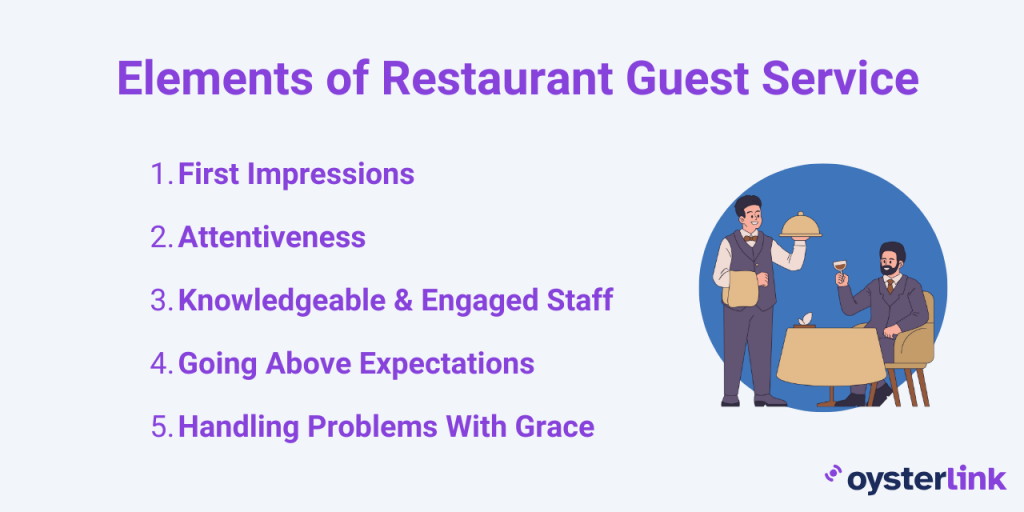Understanding guest service in a restaurant goes far beyond simply taking orders and delivering food. In fact, what sets successful restaurants apart isn’t just their menu — its their ability to create memorable moments that turn first-time visitors into loyal customers.
Whether you’re a Restaurant Manager, Server or Host/Hostess, mastering the art of guest service requires specific skills, knowledge and dedication to hospitality excellence.
This guide will show you exactly how to transform ordinary dining experiences into exceptional ones that your guests will remember. You’ll learn exactly how to build lasting relationships that drive repeat business through outstanding hospitality.
What Is Guest Service in a Restaurant?
Guest service in a restaurant is the art of making diners feel welcome, valued and well cared for throughout their experience. It’s about creating a memorable atmosphere that keeps customers coming back.
Unlike basic customer service, which focuses on fulfilling requests, guest service is proactive. It’s about anticipating needs, personalizing interactions and ensuring a smooth, enjoyable dining experience from the moment a guest walks in until they leave. This includes everything from a warm greeting at the door to a sincere farewell at the end of the meal.
At its core, great guest service is built on hospitality — the feeling that guests are not just customers but valued visitors. When done well, it leads to stronger customer loyalty, positive word-of-mouth and ultimately, higher revenue for the restaurant.
5 Core Elements of Restaurant Guest Service
Restaurant guest service excellence depends on careful attention to detail and deep hospitality knowledge.

Below are the key elements that combine smoothly to create memorable dining experiences.
1. First Impressions at the Door
Your guests’ first moments through the door shape their entire dining experience. That said, a Host/Hostess should make eye contact and offer a genuine smile within seconds of their arrival. This first interaction shows your restaurant’s dedication to great service.
Hosting involves much more than greeting and seating guests. These professionals must read body language, understand the mood of arriving parties and match them with the right tables. They work with Servers to ensure smooth service handoffs.
2. Attentiveness Without Being Overbearing
Great guest service strikes the right balance between being attentive and respecting privacy. Servers who become skilled at “subtle service” notice empty glasses, clear finished plates and anticipate needs without disrupting conversations.
Reading guest signals helps provide the right level of service. Some guests want minimal interaction, while others enjoy frequent check-ins. Servers must adapt their style while maintaining high service standards.
3. Knowledgeable and Engaged Staff
A well-trained restaurant team has complete menu knowledge and real enthusiasm for food service. Servers should answer questions about ingredients, preparation methods and wine pairings with confidence.
Staff engagement goes beyond knowing the menu. The best front-of-house teams understand timing, table dynamics and special occasion protocols. They work naturally with kitchen staff to pace courses properly.
Looking to hire restaurant staff?
Post Jobs for FreeSearching for high-paying jobs?
Find Jobs Here4. Going Above Expectations
Exceptional guest service means spotting needs before they arise. This includes:
- Remembering returning guests’ priorities
- Offering thoughtful menu suggestions based on dietary requirements
- Providing extra touches for special occasions
- Maintaining composure during busy periods
The goal isn’t just meeting expectations but creating memorable moments through customized attention. This takes constant awareness, genuine care for guest satisfaction and knowing how to turn challenges into opportunities for exceptional service.
5. Handling Problems With Grace
Even the best-run restaurants encounter issues—delayed food, incorrect orders or a guest who isn’t satisfied with their meal. How staff handle these situations can determine whether a minor inconvenience turns into a lost customer or a loyal one.
The key to resolving problems effectively is staying calm, listening and responding with empathy. Here’s how restaurant staff can manage complaints gracefully:
- Acknowledge the issue: Apologize sincerely and let the guest know their concern is being taken seriously. A simple, “I understand how frustrating that must be. Let me fix this for you,” can go a long way.
- Take swift action: Whether it’s remaking a dish, comping an item or offering a discount, resolving the problem quickly prevents frustration from escalating.
- Follow up: Checking back to ensure the guest is satisfied after a resolution shows that their experience matters. A Restaurant Manager stopping by to personally apologize can leave a lasting positive impression.
- Learn from mistakes: Use guest feedback to improve operations and prevent similar issues in the future.
Key Staff Roles in Guest Service
Each restaurant staff member plays a distinct role in creating exceptional dining experiences. Your front-of-house team needs to understand exactly what makes their position vital to the guest experience.
Host/Hostess
The Hosts/Hostesses make the restaurant’s first impression and set the tone for the guest’s experience. They welcome guests warmly and match their priorities with available tables.
These professionals do more than just greet people. They keep Servers informed about incoming guests and manage the service flow.
A Host/Hostess also tracks table status, handles waiting lists and makes sure service phases transition smoothly. The team works together to handle special requests and unexpected situations.
Server
Restaurant Servers guide guests through their dining journey. Their role goes beyond taking orders. They educate guests about menu items, suggest wines and pay attention to dietary restrictions.
Good Servers can read guest cues and know their tables without being intrusive. They coordinate with kitchen staff to ensure proper timing of courses and maintain open communication with support staff to deliver consistent service standards.
Find and apply for restaurant jobs
Restaurant Manager
The Restaurant Managers oversee all aspects of guest service operations, ensuring each team member performs effectively. They actively monitor service standards, coach staff on proper techniques and step in to handle complex guest situations that require additional attention.
Their role notably includes developing training programs that maintain service consistency. They generally focus on teaching communication skills, problem-solving techniques and methods for personalizing guest interactions. Meanwhile, they maintain an active presence on the floor, observing service delivery and providing real-time guidance to staff members.
Restaurant Managers also create systems for gathering and implementing guest feedback, helping the team continuously refine their service approach. They work closely with both front- and back-of-house teams to maintain service timing and quality standards throughout each shift.
Training Restaurant Staff for Guest Service Excellence
Successful restaurants prioritize ongoing staff development to maintain exceptional guest service standards. Training programs should focus on both technical skills and interpersonal abilities, ensuring every team member delivers consistent, high-quality service.
Basic service standards
Training programs start with fundamental service protocols that every front-of-house staff member must master. Servers learn the right way to approach tables, present menus and time their check-ins. These basics create a foundation for more advanced service skills.
Restaurant Managers implement regular coaching sessions to reinforce these standards. Through structured practice scenarios, staff members perfect their ability to handle various dining situations. Similarly, team meetings provide opportunities to share successful service techniques and address common challenges.
Technology integration plays a vital role in modern service training. Point-of-sale systems, reservation platforms and guest management tools require specific technical knowledge. Therefore, staff training includes hands-on practice with these essential systems to ensure smooth service delivery.
Communication skills development
Primarily, communication training focuses on developing active listening abilities and proper guest interaction techniques. Servers and Hosts/Hostesses learn to read body language, interpret guest cues and respond appropriately to different personality types. This understanding helps them adjust their service approach for each table.
Role-playing exercises strengthen these skills by simulating real guest interactions. Staff members practice handling special requests, addressing concerns and managing difficult situations. Consequently, they build confidence in their ability to communicate effectively under pressure.
Team feedback sessions serve as valuable learning opportunities, as these are where staff can share experiences, discuss challenging scenarios and collaborate on solutions. These discussions help refine communication techniques and build a supportive learning environment.
Restaurant Managers establish clear channels for ongoing feedback and improvement suggestions. Ultimately, this creates an atmosphere where staff feel comfortable sharing ideas and seeking guidance. Regular performance reviews track progress and identify areas for additional training focus.
What Is Guest Service in a Restaurant? – Key Takeaways
Exceptional guest service is the foundation of a successful restaurant. It’s not just about delivering food — it’s about creating an experience that makes guests feel welcomed, valued and eager to return.
From warm first impressions to personalized touches and handling complaints with grace, every interaction shapes the way customers perceive your restaurant.
By prioritizing guest service, restaurants can build stronger customer loyalty, earn positive word-of-mouth and stand out in a competitive industry. Investing in staff training, fostering a culture of hospitality and continuously improving service standards can make all the difference.
Looking to take your restaurant’s guest service to the next level? Make sure to regularly visit OysterLink for more expert tips, industry insights and hiring resources to help you build a top-performing team.
Frequently Asked Questions
Guest service in restaurants goes beyond basic customer service by focusing on creating personalized experiences and building relationships.
It involves anticipating needs, reading subtle cues and adapting service styles to match different personalities and preferences.
Each role plays a crucial part:
- Hosts/Hostesses set the first impression and manage seating.
- Servers act as personal dining guides throughout the meal.
- Restaurant Managers oversee operations, coach staff and handle complex guest situations to ensure consistent, high-quality service.
Effective training includes establishing basic service standards, developing communication skills through role-playing exercises and conducting regular coaching sessions. Technology integration, team feedback sessions and ongoing performance reviews are also crucial for continuous improvement.

Written by Eugeniu Slizovschii
With a strong background in SEO, SEM and web development, Eugeniu has helped numerous websites achieve top rankings using white-hat strategies. He’s known for his expertise in keyword research, backlinking and digital ad optimization. Beyond these, Eugeniu has firsthand experience in the U.S. hospitality industry from his university years, giving him unique insight into the field.

Reviewed by Marcy Miniano
Marcy is an editor and writer with a background in public relations and brand marketing. Throughout her nearly decade-long career, she has honed her skills in crafting content and helping build brands across various industries — including restaurant and hospitality, travel, tech, fashion and entertainment.




